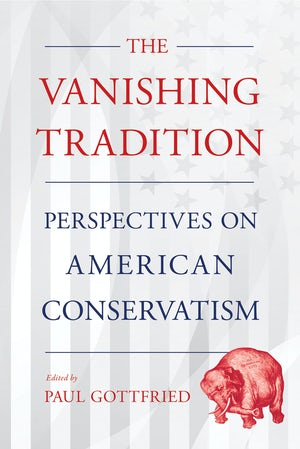The Vanishing American Conservative
Hubert Collins, American Renaissance, September 22, 2020
Paul Gottfried (editor), The Vanishing Tradition: Perspectives on American Conservatism, Northern Illinois University Press, 2020, 232+vii, $22.95 (paperback)
Paul Gottfried is a familiar name in the dissident right. Both his polemical articles and his scholarly books are regularly cited and referenced on American Renaissance, along with every website I can think of that defends white interests. I have read seven of his books, so was eager to pick up The Vanishing Tradition (TVT), a collection of essays about conservatism commissioned and edited by Dr. Gottfried.

Unfortunately, TVT largely retreads familiar ground. The majority of the book focuses on neoconservatism, both its philosophical presuppositions (which are attacked) and its political maneuvering (which is lamented). Readers familiar with paleoconservative writings on American conservatism, such as those by Sam T. Francis, Patrick Buchanan, and Dr. Gottfried himself, are sure to already be familiar with much of the subject matter: the fights for the Republican presidential nomination in 1992 and 1996, the influence of Leo Strauss and Allan Bloom, the issues with viewing America as a “propositional nation,” and the non-conservative origins and impulses of neocons themselves. The claims about all these issues are not incorrect or irrelevant; but they have all been made before, often more thoroughly — and this slim volume hardly examines the last five years of American politics, despite their being rich with examples of the trends and problems this book identifies.
There is a “time capsule” quality to much of TVT. An entire chapter explains how William Bennett, instead of Mel Bradford, became Chair of the National Endowment for the Humanities in 1981, and what it meant for American conservatism. There is no discussion of the ever-changing personnel of the Trump administration. Contributors bring up Fox News many times, generally to deride it for its support of hawkish interventionism, but no one mentions Tucker Carlson. Several authors write about neoconservative disdain for the South, but not about the Republicans who don’t fit the label “neocon” who share that disdain.
Other essays in TVT feel incomplete. “Imagination and Its Failures: The Struggle of a Conservative American Foreign Policy” touches only superficially on warring views about interventionism within the current White House. “Who Funds Conservatism, Inc.?” delves into how the military-industrial complex gives money to warmongering think-tanks, but is only six pages long. The one essay entirely about the Alt-Right is more psychological than political, and is mostly dedicated to drawing comparisons between the Alt-Right and the Situationists, a French political and cultural movement that peaked in 1968.
The two standout essays are “The Tory Right and the American Conservative Movement: Parallel Universes?” and “Republican Voters and Conservative Ideology.” The first, by Grant Havers, outlines Canadian views on American conservatism, which are interesting perspectives with which few readers are likely to be familiar. The second is by George Hawley, author of several valuable books: White Voters in 21st Century America, Right-Wing Critics of American Conservatism, and Making Sense of the Alt-Right. He surveys a lot of polling data to show that there are actually very few Republican voters who are in lockstep with mainstream conservative media, such as The Daily Wire or National Review. Even within the Tea Party, only a minority fervently oppose gay marriage, abortion, marijuana legalization, barebones economic intervention, and an aggressive foreign policy. Prof. Hawley notes that this goes a long way to explain why Conservatism Inc couldn’t stop Republican voters from rushing to the polls to vote for Donald J. Trump. The data also suggest that further revolts from “conservative” orthodoxy within the GOP are possible — if not outright likely.
Anyone interested in American conservatism would be better off reading Dr. Gottfried’s earlier books, such as The Conservative Movement, but more especially Conservatism in America: Making Sense of the American Right and The Great Purge: The Deformation of the Conservative Movement. Valuable books on neoconservatism are too numerous to name, but James Kirkpatrick’s Conservatism Inc.: The Battle for the American Right is an incisive look at internal struggles within the Republican Party, which are no longer as simple as “neoconservative vs. non-neoconservative.”















